I am the picture and the picture is me
27/05/2015
Author: Doha Hassan
The crowds fill the foreground, a river of thin bodies, faces packed between two parallel, receding lines of ruined buildings. The closest face is that of an elderly woman, wearing black shawl on her head. I’ve never seen an exhausted face with quite this kind of parched fatigue before. It is an epic image, it could be a canvas by some great artist, but the truth is it is just a single snapshot from the siege of the Yarmouk Camp in Damascus.
How can an image such as this be beautiful, so very beautiful?
We are used to describing colours as beautiful when we talk about the sky or flowers, the sea or mountains, but how is it we can describe an image like this as beautiful? As an extremely beautiful image?
Artistic beauty is said to stem from the mutual agreement of constituent parts, from elements and their harmony, but images of war broke this old, traditional rule. Blew it apart, in fact. For they possess none of the aforementioned attributes, but rather the opposite: their disorder is the basis of their beauty. It is further claimed that the beautiful image is one that reproduces a reality and details that convey pleasure and enjoyment to the viewer, but the beauty of many images of war and siege and destruction and natural disasters manifests in misery.
I showed the image from Yarmouk to a group of individuals who had not directly experienced the siege themselves. Is it possible, I asked, to describe an image like this as beautiful? “Yes,” said Rima. “It’s a beautiful image, because it conveys the state of wretchedness and pain, the Yarmouk siege and the destruction: in other words, it perfectly conveys the reality of our country as it is.” Here, it seems, the image’s beauty (its aesthetics) derive from the image’s oneness with reality and the distressing effect it has on the viewer.
“The artist can compose only what of itself gathers together and composes itself,” says Heidegger, but the fact is that most of the visual imagery captured in Syria is produced by people carrying camera or other devices then suddenly pointing them at their target and pressing the button for reality to appear as art: the viewer as witness, where the witness carries the camera.
Look at the image again. It could be somewhere in Syria, Iraq, or Palestine, from the First World War or the Second. “The image reminds me of the war in Germany,” said a young German: “Of pictures of my city, which was destroyed.” So, we can deduce that the reason this German viewer is affected by the image is its connection to a personal experience of his own. “It’s really a magical image,” he went on.
Two parallel lines of destroyed buildings in the same place—Yarmouk Camp—completely empty save for lumps of rock scattered here and there. “The previous picture was more affecting,” said Yazan. “Maybe because it contained people. This one’s ordinary.” In other words, the image of the very same spot but devoid of people does not affect the viewer—it has lost an aesthetic and artistic attribute, and the absence of human interest means we can no longer escape our awareness of its artistic disorder.
For the past four years we have witnessed a flood of imagery depicting events in Syria (among other places) a torrent made up of pictures and video clips and numerous short films showing the bloody reality: body parts, corpses, torture, and so on. Visual material that has been gobbled up by the media and international regional film festivals, transforming the images from objects devoid of any artistic attributes into artworks that compete in competitions and festivals, winning awards like “best photograph” and “best documentary film”. Furthermore, they have become the secret to negating nihilism: the desire to transform life’s inconsistencies and contradictions into an artistic and aesthetic phenomenon.
“Those pictures which contain a world that lets me understand my own condition, affect me more because I feel they concern me personally,” commented Louay, as though the viewer’s response to visual imagery is based first and foremost on a series of mental and psychological processes that enable him to reify his own person and his surroundings. In other words, those that touch on his selfhood, his fears, dreams, nightmares, reality, and life.
To return to the original question: how can a picture like that be beautiful? We might not be able to place the image within traditional aesthetic categories, or to evaluate it in art historical terms, since its subject matter is brutal and violent, tragic, in fact. This is why we try to frame it in technical terms.
“The photographic image has five dimensions: length, breadth, depth, place (and therefore, environment), and, fifth and finally, motion. The intersection of the fourth and fifth dimensions constitute the event itself. This is why the image will prove worthless if we attempt to judge it as a work of art—unless we evaluate it by the standards of journalistic photography, which is based on the fourth and fifth dimensions, overruling the first three,” states photographer Muzhafar Salman: “That is why we can view a lot of images that would be considered poor in terms of their aesthetic composition, but which can have high value in terms of public memory (and public taste). It explains why Roland Barthes once said, ‘the photograph requires its own special branch of aesthetics: the photograph sweeps away the concept of art, and thereby plays its part in the development of society.’” In recent years, Muzhafar Salman has worked for Reuters within Syria.
Let us construct that same image: The crowds fill the foreground, a river of thin bodies, faces packed between two parallel, receding lines of luxurious buildings. The closest face is that of an elderly woman, wearing black shawl on her head. I’ve never before seen an exhausted face with quite this kind of parched fatigue.
The image is taken in Taksim Street in Istanbul: a normal day in a crowded city.
In its first three dimensions—length, breadth, and depth—the image perfectly corresponds to the photograph from Yarmouk: the angle, the light in the background, the extent to which the buildings occupy the composition, the human mass. Can a picture like this be called beautiful?
Art philosophers have long searched for a fundamental criterion on which artwork and its influence can be assessed. In the nineteenth century they split into two schools of thought: content vs. image. The pioneers of both posed many questions: Is art based on the image alone? On content alone? On both? This same confusion can be clearly perceived in the commentary offered by public opinion today: “The piece is great in terms of technique but the idea is weak”; “The techniques used to produce this work are clever, but the content’s superficial”; “An excellent text in terms of structure but consumerist” or the opposite—as if they believe they can describe one aspect of a work as “art” whilst denying that same description to another: splitting the body from the soul.
In his “Philosophy of art”, Benedetto Croce wrote: “It is all the same, therefore, whether we consider art to be content or image, so long as content is present in the image and the image is full of content.”
Against all the above
In amongst the crowds that fill the foreground is a thin body, a youthful face between two receding parallel lines of ruined buildings. A youth I know well. The truth is that I can’t see him in this image, but I imagine him there. I know he’s there somewhere, in their midst. In fact, I am completely certain that Abdullah Al Khatib is there, inside the frame.
I sent him the picture. I asked him the same question: How can an image such as this be beautiful, so very beautiful?
“An everyday scene. I’ve seen it often: hundreds of times in and around the camp. What I see in the picture isn’t beautiful or horrible because, quite simply, I am the picture and the picture is me.”



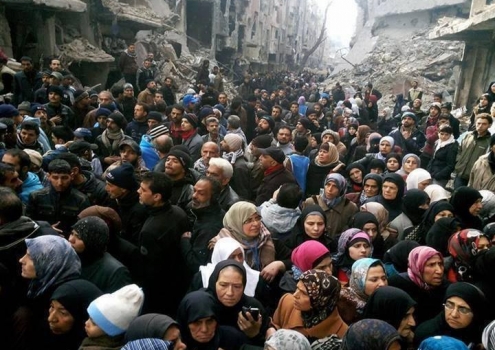




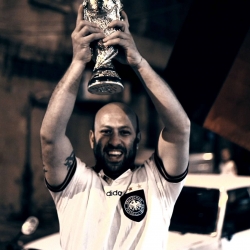
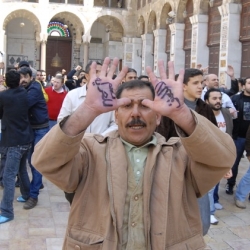
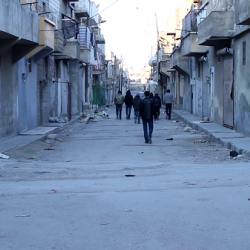

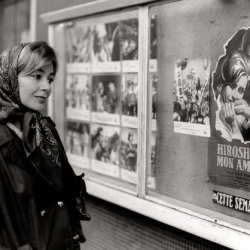
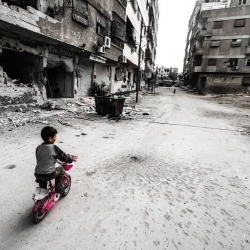
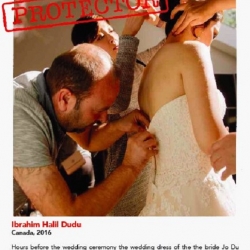
.jpg)
